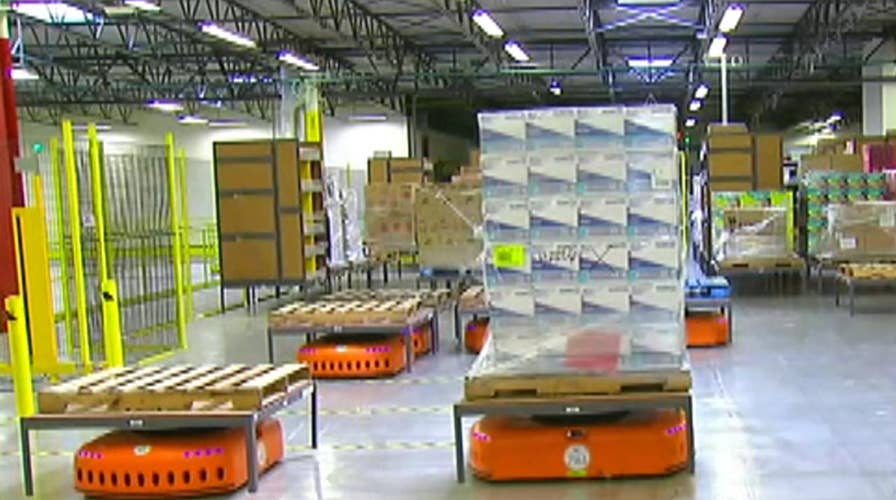Will robots forever change the workspace?
A recent study found that up to a third of the American workforce will have to switch occupations by 2030 to find work, thanks in large part to rapid advances being made in automation and robotic technology.
After Monday’s punt by the Supreme Court – declining for now to involve itself in the Deferred Action for Childhood Arrivals (DACA) fight – the debate over America’s immigration system will likely continue for many months to come. Yet the debate will almost certainly not be the one that we need.
To date, politicians and pundits have focused mostly on how foreigners have been helpful or harmful to our nation in the past. Instead, we should be looking at what role immigrants will likely play in the future.
In other words, will America still need people from abroad in our future economy? For reasons beyond politics, the answer will increasingly be that we will not.
Why? Blame the robots.
In late 2016 the Obama administration published an alarming study that showed upwards of 47 percent of American jobs might be eliminated due to the technological advances in robotics, automation and machine learning (RAML). The most vulnerable jobs included those filled by workers with lower pay, lower skills and less education.
President Obama’s team further warned that most Americans making less than $20 an hour – the average wage for U.S. factory workers – would likely be “automated into obsolescence.”
While this doesn’t bode well for many blue collar Americans, it’s especially bad news for immigrants. Some 60 percent of new arrivals have a minimal education and few advanced skills. Not surprisingly, the top 10 immigrant jobs don’t pay anywhere near the $20 cutoff.
Manicurists earn an average of $9.43 an hour. Agricultural sorters pull in an average hourly wage of $9.57. Construction workers make an average of $12.46 an hour.
In bygone eras, these low-wage immigrants could be expected to eventually rise up the economic ladder. But not future immigrants. Instead, many will be part of the workforce that President Obama believed would be made obsolete by automation.
And it isn’t just the former president who has sounded the alarm. There are many others as well.
One of the earliest was Oxford University, which forecast that some 47 percent of jobs in the U.S. were at risk from RAML technologies. The World Economic Forum later joined in with a forecast of millions of jobs lost for the same reasons.
In 2015 and 2017, consultants McKinsey & Company published studies warning that some 49 percent of human activities could be automated with today’s technology – and we all know that technology will grow more sophisticated each year.
These experts based their estimates, in part, on the dramatic investments in the RAML economy. In 2016 alone, American companies and investors plowed at least $1.9 billion into robotics and over $20 billion into machine learning.
The results have been impressive. There’s a humanoid robot that can do backflips and a self-driving truck that can navigate interstate traffic while delivering beer.
Meanwhile, the software and related algorithms that power these robots now handily beat humans at complex games and even design new versions of themselves – without the involvement of human computer scientists.
All told, the world’s leading experts are offering up an ominous – if unprovable – bottom line: the future economy will simply need fewer workers. For those left behind, their governments and fellow taxpayers will be on the hook for the trillion-dollar solutions to feed, clothe and house them.
Thus the question isn’t about whether America needs immigrants. Rather, we must wrestle with how America will provide for those citizens already here. Moreover, we must find ways to strengthen our families and communities to prepare for the new economic order.
Silicon Valley understands this existential challenge and is working on solutions.
Microsoft founder Bill Gates has proposed a “robot tax” that would fund retraining programs for humans.
Meanwhile, Facebook’s Mark Zuckerberg and Tesla’s Elon Musk are pushing for a universal basic income, or a guaranteed paycheck for simply being a citizen. Their colleague Sam Altman and his group Y Combinator have rolled out a study to see how or if it might work.
Other thought leaders have offered different solutions. I have suggested data mining royalties and highlighted impactful organizations like Innovation Collective.
Regardless of the approach, studies show that the time for solutions is limited.
Last March, leading economists at Boston University and MIT demonstrated that each industrial robot introduced in the U.S. since 1990 has led to the loss of three to six jobs and pushed wages down for remaining workers.
In other words, the economic challenges of RAML technologies aren’t just the stuff of scaremongers or futurists. The impacts are already here.
This will come as a surprise to most Americans, because 80 percent don’t believe they’ll be impacted by the RAML economy. Even some in the Trump administration share their skepticism, including Treasury Secretary Steve Mnuchin. He recently argued that the impact of robots and machine learning wouldn’t be seen for another 50 to 100 years.
“It's not even on our radar screen,” Mnuchin said.
Unfortunately, the data and reasonable forecasts tell us that we don’t have another 50 to 100 years. Prudent policymakers on both sides of the aisle should recognize that government policies will likely need to change – and soon.
That includes immigration.
Democrats must accept that open borders are not fiscally sustainable and that tough choices must be made about whom and how many immigrants we embrace.
Republicans, for their part, must challenge their party’s orthodoxy on degrading the social safety net. Rather than reducing or eliminating support, universal basic income programs will almost certainly be needed or expanded.
Ready or not America, this is our brave new world. The immigration debate should reflect it.





















